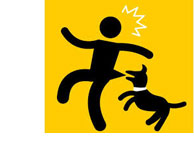 | Page 24 of 25 |  |
PUNCTURE WOUND

A puncture wound can be dangerous because of the risk of infection. The object that caused the wound may carry spores of tetanus or other bacteria, especially if the object had been exposed to the soil. Puncture wounds resulting from human or animal bites, including those of domestic dogs and cats, may be especially prone to infection.
See a doctor if:
• The wound is deep
• The wound is in your foot
• The wound is contaminated
• The wound is the result of an animal or human bite
Bite Wounds
• If the bite barely breaks the skin and there is no danger of rabies, treat it as a minor wound. Wash the wound thoroughly with soap and water. Apply an antibiotic cream to prevent infection and cover the bite with a clean bandage.
• If the animal bite creates a deep puncture of the skin or the skin is badly torn and bleeding, apply pressure with a clean, dry cloth to stop the bleeding and see a doctor.
• If you notice signs of infection such as swelling, redness, increased pain or oozing, see a doctor immediately.
• If you suspect the bite was caused by an animal that might carry rabies see a doctor immediately.
Domestic pets cause most animal bites. Dogs are more likely to bite than cats. Cat bites, however, are more likely to cause infection. Bites from non-immunized domestic animals and wild animals carry the risk of rabies. Rabies is more common in raccoons, skunks, bats and foxes than in cats and dogs. Rabbits, squirrels and other rodents rarely carry rabies. If an animal bites you or your child you must thoroughly clean the wound by washing with soap and tap water as soon as possible. Then put a clean and dry bandage over the area. This treatment should not replace proper evaluation by a doctor.
 | Page 24 of 25 |  |




